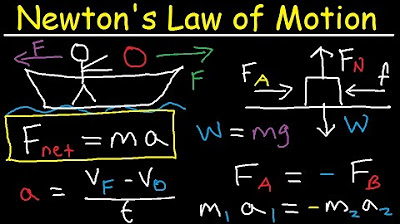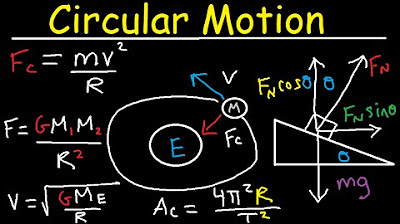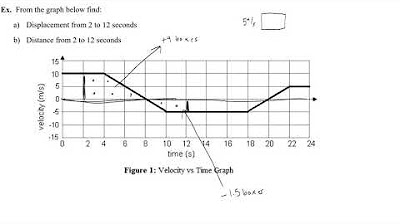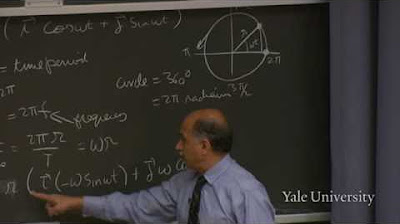Lecture 17: Galileo, Newton and Baseball
TLDRIn this educational video, the host explores the application of calculus to describe the motion of moving objects, such as projectiles. Starting with Galileo's experiments that refuted Aristotle's claims about falling bodies, the video delves into Newton's laws of motion and universal gravitation. It explains how these principles can predict the trajectory of objects like cannonballs and baseballs. The host also discusses the historical misunderstanding of projectile motion and uses the example of a baseball outfielder to illustrate how calculus can determine the optimal position to catch a fly ball. The video concludes with a whimsical scenario of playing baseball on a theoretical Earth, emphasizing the importance of calculus in understanding real-world motion.
Takeaways
- 📚 The script discusses the application of calculus in describing the motion of moving objects, particularly in the context of projectiles like cannonballs and baseballs.
- 🌟 Galileo refuted Aristotle's claim that heavier bodies fall faster than lighter ones through experiments, demonstrating that all bodies fall at the same rate in a vacuum.
- 📉 Newton's laws of motion and universal gravitation are foundational in understanding how objects move and interact, with the second law (F=ma) linking force, mass, and acceleration.
- 🚀 The script explains that the path of a projectile is influenced by the force of gravity, which causes a constant acceleration of approximately 32 feet per second squared near the Earth's surface.
- 🧭 Newton's law of universal gravitation states that the gravitational force between two objects is proportional to the product of their masses and inversely proportional to the square of the distance between them.
- 📈 The trajectory of a projectile can be described mathematically using calculus, allowing for the prediction of where it will land based on initial conditions.
- 🏀 In baseball, outfielders can use calculus to predict where to position themselves to catch a fly ball by analyzing the ball's trajectory and the rate at which it rises and falls.
- 🔢 The script provides a mathematical example of calculating the landing position of a baseball hit with specific initial vertical and horizontal velocities.
- 📚 Historically, before calculus, the trajectory of projectiles like cannonballs was misunderstood, often depicted as moving straight up and down in a simple vertical path.
- 🎯 The concept of an outfielder in baseball computing the calculus to catch a ball is illustrated with the famous example of Willie Mays making a play during the 1954 World Series.
- 🌍 The script humorously concludes with a thought experiment about playing baseball on a theoretical Earth with all its mass concentrated at the center, resulting in a very different game dynamic.
Q & A
What is the main theme of the lecture?
-The main theme of the lecture is the application of calculus in describing the motion of moving objects, particularly in the context of projectiles like cannonballs, baseballs, and planets.
What did Galileo's experiments at the Leaning Tower of Pisa intend to demonstrate?
-Galileo's experiments were intended to demonstrate that the velocity with which falling bodies fall is not dependent on their weight, refuting Aristotle's assertion that heavier bodies fall faster than lighter ones.
What is the significance of Newton's time at his family estate during the plague?
-During the plague, when Cambridge University was closed, Newton spent two years at his family estate developing fundamental ideas, including the basic concepts of calculus, laws of planetary motion, and universal gravitation.
What is Newton's law of universal gravitation?
-Newton's law of universal gravitation states that the force of gravity between any two objects is proportional to the product of their masses and inversely proportional to the square of the distance between them.
What are Newton's three laws of motion?
-Newton's first law (also known as the law of inertia) states that a body at rest will remain at rest, and a body in motion will remain in motion at a constant velocity unless acted upon by a force. The second law states that the force acting on an object is equal to the mass of the object times its acceleration (F = ma). The third law states that for every action, there is an equal and opposite reaction.
What is Kepler's first law of planetary motion?
-Kepler's first law of planetary motion states that planets move in elliptical orbits around the Sun, with the Sun at one focus of the ellipse.
How does the lecture describe the motion of a baseball thrown straight up?
-The motion of a baseball thrown straight up is described by an initial velocity that is gradually reduced by gravity, resulting in a parabolic trajectory. The height of the ball at any time t can be calculated using the formula 48t - 16t^2, where t is the time in seconds.
How can an outfielder in baseball determine the optimal position to catch a fly ball?
-An outfielder can determine the optimal position by observing the angle at which the ball is hit and calculating the slope of the line of sight, which changes at a constant rate when the outfielder is at the correct position to catch the ball.
What is the significance of the slope of the line of sight for an outfielder?
-The slope of the line of sight is significant because if it changes at a constant rate, it indicates that the outfielder is at the exact position where the ball will land.
What is the theoretical scenario presented in the lecture where the outfielder does not need to compute where the ball will land?
-The theoretical scenario is one where the entire mass of the Earth is concentrated at the center, and a projectile would follow an elliptical orbit around this center. The outfielder would not need to compute where the ball will land because it would eventually return to the point of impact.
Outlines
🚀 Introduction to Calculus in Motion and Projectiles
This paragraph introduces the application of calculus in understanding the motion of objects, particularly in projectile motion. It discusses the historical context, mentioning Galileo's experiments with falling bodies and Newton's laws of motion and universal gravitation. The lecturer aims to explain how calculus can describe the path and velocity of projectiles, including cannonballs, baseballs, and planets. The paragraph also refutes Aristotle's claim that heavier bodies fall faster than lighter ones, using Galileo's experiments as evidence that all bodies fall at the same rate in the absence of air resistance.
🌌 Newton's Laws and Kepler's Influence on Celestial Mechanics
The second paragraph delves into Newton's formulation of the law of universal gravitation, which posits that the gravitational force between two objects is proportional to the product of their masses and inversely proportional to the square of the distance between them. It also touches on Newton's anecdotal inspiration from a falling apple. The paragraph outlines Newton's three laws of motion, which include Galileo's principle of inertia, the relationship between force, mass, and acceleration (F=ma), and the principle of action and reaction. Additionally, it discusses Kepler's laws of planetary motion, particularly the elliptical orbits of planets, and how Newton's laws could explain these observations.
📉 Simple Mathematical Models for Falling Bodies
This paragraph presents a simplified mathematical model for the motion of a falling body under the influence of gravity, assuming constant acceleration. It explains that an object dropped near the Earth's surface will accelerate at approximately 32 feet per second squared, directed downward. The paragraph further illustrates how to calculate the velocity and position of a falling object over time, using basic calculus concepts. The讲师 also clarifies that this model is an approximation that holds true for objects falling over short distances near the Earth's surface, where gravitational acceleration can be considered constant.
🏀 Analyzing the Trajectory of a Thrown Baseball
The fourth paragraph extends the discussion to the motion of a thrown baseball, considering both its vertical and horizontal components. It provides an example where a ball is thrown with an initial vertical velocity of 48 feet per second and a horizontal velocity of 100 feet per second. The讲师 uses calculus to derive the equations for the ball's velocity and position over time, ultimately determining where and when the ball will land. This analysis is crucial for understanding how outfielders in baseball can predict the landing point of a fly ball.
🤔 Calculus and the Art of Outfielding in Baseball
In this paragraph, the lecturer explores the practical application of calculus in baseball, specifically for outfielders determining their position to catch a fly ball. It explains how the outfielder can use the angle of the ball's trajectory and the rate at which the angle changes to predict the landing point. The讲师 demonstrates that the key is for the outfielder to stand at a position where the slope of the line of sight to the ball changes at a constant rate, indicating the ball's landing spot. The paragraph also recounts the famous 'The Catch' by Willie Mays during the 1954 World Series as an example of such calculations in action.
🎰 Theoretical Baseball on a Mass-less Earth
The final paragraph presents a theoretical scenario where a baseball game is played in an environment where the Earth's mass is concentrated at its center, resulting in a gravitational field that could cause a projectile to follow an elliptical orbit. In this hypothetical situation, an outfielder would not need to calculate the ball's landing spot but could simply wait for the ball to orbit back to the point of impact. The lecturer humorously concludes that baseball is not played in such a theoretical Earth, where there is no land to play on, and looks forward to the next lecture on computing distances traveled by moving objects.
Mindmap
Keywords
💡Calculus
💡Derivative
💡Integral
💡Projectile Motion
💡Galileo
💡Newton's Laws of Motion
💡Universal Gravitation
💡Kepler's Laws of Planetary Motion
💡Trajectory
💡Outfielder
Highlights
Calculus is used to describe the motion of moving objects, such as projectiles.
Galileo refuted Aristotle's claim that heavier bodies fall faster with his experiments.
Galileo's experiments suggested that in a vacuum, all objects fall at the same rate regardless of their mass.
Newton developed the law of universal gravitation during his time away from Cambridge due to the plague.
Newton's laws of motion and gravitation laid the foundation for understanding the motion of celestial bodies.
Kepler's laws of planetary motion were explained by Newton's law of universal gravitation.
The motion of a falling body can be described by a simple equation involving constant acceleration due to gravity.
The concept of projectile motion involves both horizontal and vertical components.
Baseball outfielders can use calculus to predict where to stand to catch a fly ball.
The trajectory of a projectile can be calculated using calculus to determine where it will land.
Outfielders can determine the optimal position to catch a ball by analyzing the slope of the line of sight.
Willie Mays' famous catch in the 1954 World Series is an example of applying calculus in baseball.
Historical misunderstandings of projectile motion led to incorrect depictions of cannonball trajectories.
In a theoretical scenario with Earth's mass concentrated at its center, a baseball could follow an elliptical orbit and return to the batter.
The lecture concludes with a look forward to future lessons on computing additional features of moving objects in space.
Transcripts
Browse More Related Video

Newton's First Law of Motion | Newton's Laws of Motion | Video for Kids

Lecture 18: Getting Off the Line Motion in Space

Newton's Law of Motion - First, Second & Third - Physics

Centripetal Acceleration & Force - Circular Motion, Banked Curves, Static Friction, Physics Problems

How to find Area of a Velocity vs Time Graph

2. Vectors in Multiple Dimensions
5.0 / 5 (0 votes)
Thanks for rating: